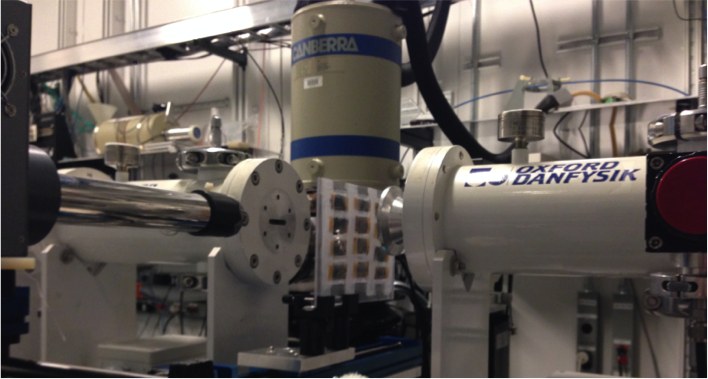Minerals, Metals, & Microbes
Ongoing Projects
W&L Undergrads: Want to join the W&L Geochemistry lab? Contact Prof. Hinkle (via email) or stop by my office to set up a time to chat
Rare earth element and yttrium extraction by biotic and abiotic hydrous manganese oxides associated with acidic mine drainage
With the projected growth in renewable energy and technology sectors, along with their increasing reliance on critical minerals such as rare earth elements, yttrium, and manganese, identifying domestic sources of these critical minerals is essential. Large volumes of solid waste containing critical minerals are generated every year as a byproduct of acid mine drainage remediation. Within the United States, acid mine drainage remains an ongoing environmental issue. This research will examine the potential of adapting acid mine drainage remediation systems to produce critical minerals in economically viable concentrations.
U of Pittsburgh PI: Rosemary Capo & co-PI Brian Stewart
Washington & Lee PI: Margaret Anne G. Hinkle
W&L Students Who Are Working on Project: Riley Mitchelson (W&L C’28)
Non-W&L Students Who Are Working on Project: Tashane Booth (U of Pittsburgh)
Funding: National Science Foundation EAR Collaborative Research GEO-CM Grant (2024-2027)
Stagonospora sp. SRC1lsM3a in synthetic coal mine drainage + Mn2+ and limestone. Dark black particles are mycogenic Mn oxide minerals!
Improving Manganese Bioremediation from Coal Mine Drainage
Manganese-oxidizing fungi are very important in many natural and metal-polluted systems (such as coal mine drainage remediation sites). In the Hinkle lab we are investigating the interactions between Mn oxidizing fungi, Mn, and trace metals with other other minerals commonly found at coal mine drainage sites that can impact water chemistry in the hopes to improve passive bioremediation methods.
PI: Margaret Anne G. Hinkle
W&L Students Who Have Worked / Are Working on Project: James Edwards, Kass Loera, Aden Boyd, Nicolas Angustia, Ngoc Alicia Nguyen, Sarah Teagle, Qiang Nguyen, Sarah Cate Harrison
Funding: Virginia Foundation of Independent Colleges’ Mednick Memorial Fellowship, Washington and Lee’s Lenfest Program
Keck student researchers on a kayak trip to visit a field site, an old mill dam, along the Maury River in Rockbridge County, VA.
Historical & Potential Future Impacts of Mill Pond Dams on Surface Water Quality
Increased aqueous Fe & Mn concentrations (& associated trace metals) in surface water is linked with the stratification of impounded waters behind dams, negatively impacting surface water quality and surrounding ecosystems. In addition to these geochemical effects, another major consequence of dams includes reservoir infilling with sediments. These legacy sediments are stored behind dams that were constructed in the eastern United States from the earliest days of European settlement until the early 1900s. Legacy sediments can potentially record evidence of land use changes to the land, such as urbanization and industrial and agricultural activities and thus can serve as important archives of colonial and antebellum land use history. The Shenandoah Valley is home to many historical low head dams, primarily used for mills, iron forges, and other hydropower applications. Many of the dams have been breached over the years, either as a result of ongoing fluvial processes, aging infrastructure, or in response to calls for the removal of dams for a host of reasons, including their safety concerns. With this project we are characterizing some of these legacy sediments and corresponding aqueous geochemistry behind dams along the Maury River in Rockbridge County, Virginia. The aim of this work is to better assess their potential for erosion into and contamination of the waterway, and downstream water bodies like the Chesapeake Bay.
To learn more about this project, check out the Keck Geology Consortium Website: https://keckgeology.org/2021/01/virginia2021/
PI: Eva C. Lyon
Co-PI: Margaret Anne G. Hinkle
W&L Students Who Have Worked on this Project: Katie Larkin (C’22)
Funding: Keck Geology Consortium
Check out this recording of Eva discussing this work at University of Kentucky’s Geoscience & Environmental Justice in Appalachia series here
Plectosphaerella cucumerina DS2psM2a2 + 0.2 mM Mn2+. The black/brown suspended particles are mycogenic Mn oxide minerals
Interactions between Mycogenic Mn Oxides & Trace Metals
Manganese oxide minerals --which often control trace metal concentrations in the environment-- can undergo structural changes resulting in altered reactivities toward trace metals. Manganese-oxidizing fungi are very important in many natural and metal-polluted systems (such as coal mine drainage remediation sites). In our lab we are investigating the long term stability of mycogenic manganese oxide mineral structures and how associated trace metals are partitioned between the aqueous and solid phases as well as their binding mechanisms.
PI: Margaret Anne G. Hinkle
W&L Students Who Have Worked on this Project: Sarah G. Teagle (C’23)
Funding: Washington & Lee University’s Lenfest Program and Peter Buck Fellowship Program through the Smithsonian Institution’s National Museum of Natural History
Past Projects
One the sampled spring sites for this project in the Shenandoah Valley, VA. Iron oxide minerals are visible as red precipitates from the anoxic Fe-rich spring water oxidizing upon contact with air (and perhaps some help from microbial friends)!
Manganese in Springs & Groundwater Wells Across the Shenandoah Valley, VA, USA
Mn contaminated GW wells have been identified in several locations throughout Virginia, including the upper portion of the Shenandoah Valley. Potential geogenic sources of Mn and trace metal contamination in VA groundwater include: dissolution of the aquifer, soil-water or sediment-water interactions, Mn mobilization via desorption from mineral surfaces in the soil-water interface, etc. We are investigating the role of land use patterns, soil geochemistry, aquifer type, and nearby stream compositions on Mn and other heavy metal concentrations in ground and surface waters in the Shenandoah Valley region of Virginia. This region was selected because of the high concentrations of Mn in several wells in this area (McMahon et al. 2018), variable land use practices throughout the region, and potential for Mn and heavy metal inputs from historical ore mining operations. With GW well data supplied through a collaboration with the Virginia Household Water Quality Program (VAHWQP), Mn concentrations in springs are not as well documented in this region. As springs are used as private drinking water sources in this region, we are also analyzing spring water and nearby soil cores throughout the region.
To learn more about the initial plan of the project, check out the Keck Geology Consortium Website: https://keckgeology.org/2021/01/virginia2021/
To learn more about the results of the project, check out this article.
PI: Margaret Anne G. Hinkle | Co-PI: Eva C. Lyon
W&L Students Who Have Worked on this Project: Haley Culbertson (C’22), Marina Ani Croy (C’22)
Non-W&L Students Who Have Worked on this Project: Noah Willis (C’22 Whitman College), Christopher Goldmann (C’22 Trinity University)
Funding: Keck Geology Consortium
Resulting Publication:
*Hinkle M.A.G., Ziegler B., ‡Culbertson H., ‡Goldmann C., ‡Croy M.E., ‡Willis N., Ling E., Reinhart B., Lyon E.C. (2024) “Manganese exposure from spring and well waters in the Shenandoah Valley: interplay of aquifer lithology, soil composition, and redox conditions.” Environmental Geochemistry and Health 46, 203, 1-27. [link]
Air dried synthesized delta-MnO2 imaged through a plain old microscope.
Sulfonic Acids & Fungal Mn Oxide Minerals
The effects of sulfonic acids, a large class of sulfur bearing compounds, common in both natural and contaminated environments and used as pH buffers, on the process of manganese (Mn) oxidation by three types of fungi. Our study finds that sulfonic acids (in particular, the Good’s buffers HEPES and MES) can significantly alter the way Mn is oxidized and the structure of resulting Mn oxides, with the specific impact varying with the type of fungus involved. The research emphasizes the complex interplay between microbial activity, Mn oxidation, and environmental factors, highlighting the need for a deeper understanding of these processes, especially in environments with fluctuating redox conditions. Read about the project here.
PI: Margaret Anne G. Hinkle
W&L Students Who Have Worked on this Project: Javier Peralta (C’21)
Funding: Washington & Lee University’s Lenfest Program, Smithsonian Institution National Museum of Natural History Peter Buck Postdoctoral Fellowship
Resulting Publication:
*Hinkle, M.A.G., Post, J.E., ‡Peralta, J., Santelli, C.M., 2023. Impacts of sulfonic acids on fungal manganese oxide production. Geochimica et Cosmochimica Acta 341, 164–182. https://doi.org/10.1016/j.gca.2022.11.032
Mn oxide samples at 5-BM-D at the Advanced Photon Source -ready to collect XAFS spectra!
Ni, Zn, & Manganese Oxide Structures at Redox Interfaces (i.e., with coexisting Mn(II)aq & Mn(III/IV) solids)
At redox interfaces (i.e., subsurface environments, redoximorphic soils, marine & lacustrine sediment-water interfaces, aquifers, etc.), manganese in both reduced [i.e., dissolved Mn(II)] and oxidized [i.e., Mn(IV/III)--most stable as manganese oxide minerals] forms can coexist. I researched the effects of soluble Mn(II) on solid Mn(IV/III) oxide structures, as well as how such processes can impact trace metals.
PI: Jeff Catalano
Funding: NSF
Resulting Publications:
*Hinkle M.A.G., Becker K.G., Catalano J.G. (2017) “Impact of Mn(II)-Manganese oxide reactions on Ni and Zn speciation.” Environmental Science & Technology 51(6), 3187-3196. [link]
*Hinkle M.A.G., Flynn E.D., Catalano J.G. (2016) “Structural response of phyllomanganates to wet aging and Mn(II).” Geochimica et Cosmochimica Acta 192, 220-234. [link]
Schematic showing an example of ternary complexes between Fe(II) and phosphate/sulfate on a hematite surface
Oxoanions + Fe(II)(aq)-Fe(III) Oxide Interactions
Fe(II) adsorption onto Fe(III) oxides can involve redox processes, resulting in Fe(II)-catalyzed Fe(III) oxide recrystallization. Oxoanions often alter cation adsorption onto mineral surfaces via ternary complexation, electrostatic interactions, or competitive adsorption processes. Focusing on sulfate and phosphate, two ligands commonly found in natural systems, we investigated their impact on Fe(II) adsorption onto hematite and goethite using a combination of wet chemistry, FTIR spectroscopy, and surface complexation modeling. I found that both phosphate and sulfate enhance Fe(II) adsorption onto both minerals, and that oxoanion adsorption mechanisms are altered in the presence of Fe(II), suggesting that oxoanions form ternary complexes with Fe(II) on Fe(III) oxide surfaces. Surface complexation modeling confirmed the formation of oxoanion-Fe(II) ternary complexes on Fe(III) oxides. These results indicate that phosphate and sulfate may affect processes associated with Fe(II)-catalyzed Fe(III) oxide recrystallization, such as trace metal repartitioning.
PI: Jeff Catalano
Funding: NSF
Resulting Publication:
*Hinkle M.A.G., Wang Z., Giammar D.E., Catalano J.G. (2015) “Interaction of Fe(II) with phosphate and sulfate on iron oxide surfaces.” Geochimica et Cosmochimica Acta 158, 130-146.
Prepping XAFS samples for beamtime inside the anaerobic chamber
Nickel + Oxoanions + Fe(II)aq-Fe(III) oxide Intearctions
As a natural extension of the oxoanion-Fe(II)(aq)-Fe(III) oxide research, we were interested in the effects oxoanions like phosphate and sulfate may exert on Ni repartitioning (i.e., the redistribution of Ni surface complexes and incorporated Ni) during Fe(II)-catalyzed Fe(III) oxide recrystallization. I found that the effects of phosphate and sulfate are distinct, with phosphate having a more substantial macroscopic impact on Ni uptake than sulfate. Interestingly, Fe(II)-catalyzed Ni repartitioning in goethite and hematite show distinct behavior, with Ni cycling through goethite being either permitted or enhanced by the oxoanions but through hematite being suppressed by both oxoanions (nearly inhibited in the case of phosphate). These results suggest that phosphate may have a particularly large effect on soils and sediments that experience variable redox conditions and are dominated by hematite (e.g., hydrothermal vents, waterlogged (sub)tropical soils).
PI: Jeff Catalano
Funding: NSF
Resulting Publication:
*Hinkle M.A.G. and Catalano J.G. (2015) “Effect of phosphate and sulfate on Ni repartitioning during Fe(II)-catalyzed Fe(III) oxide mineral recrystallization.” Geochimica et Cosmochimica Acta 165, 62-74.








